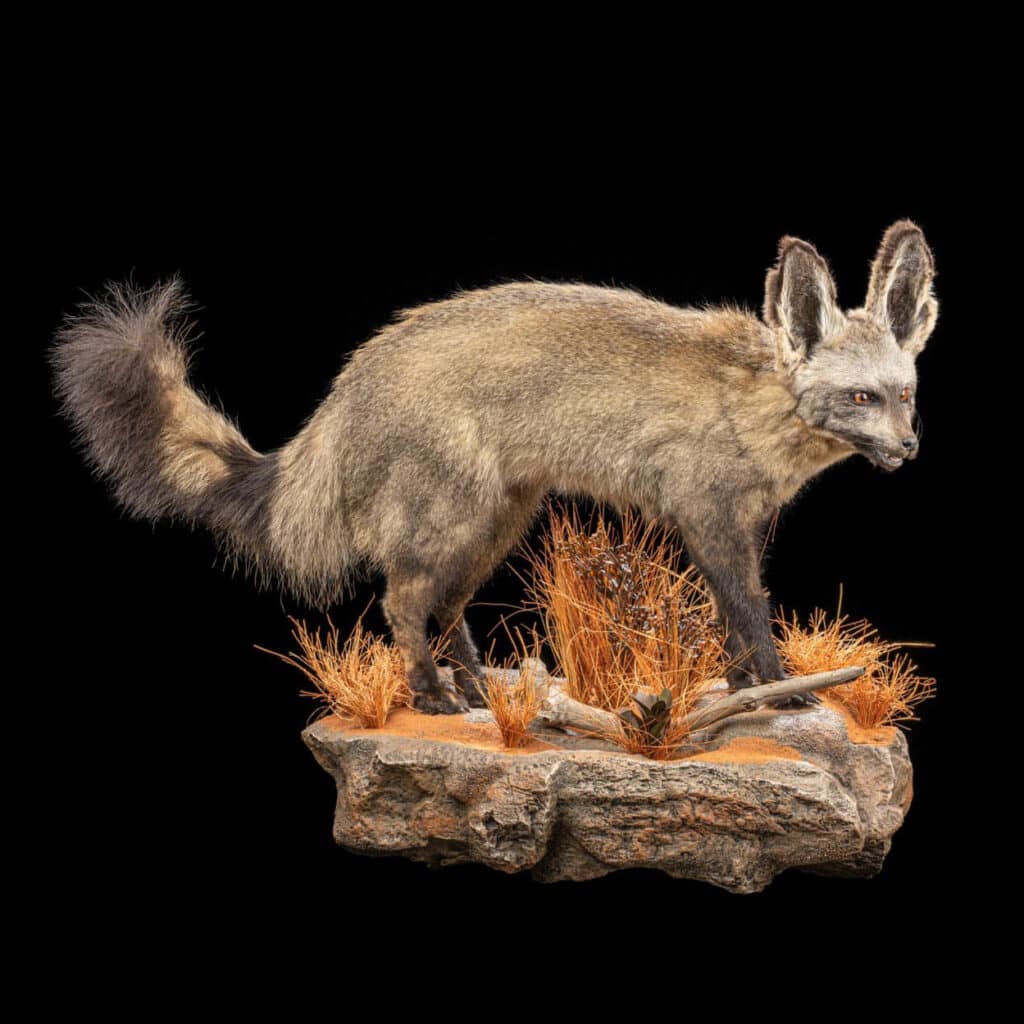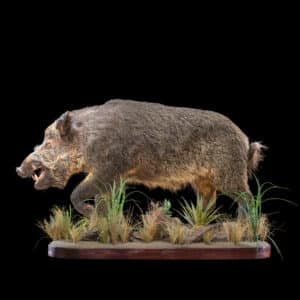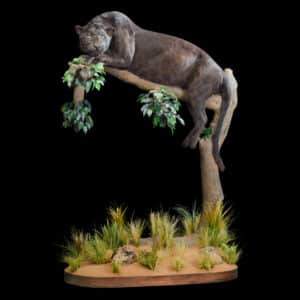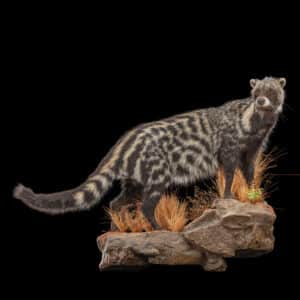Facts
Cape Fox
The Cape Fox (Vulpes chama), also called the Asse, Camp Fox or the Silver-Backed Fox, is a small species of Fox, native to Southern Africa. It is the only “true Fox” occurring in sub-Saharan Africa.
Cape Fox is a small-built canid, usually measuring 45 to 62 cm (17.5 to 24.5 in) long, not including its tail, which is typically 30 to 40 cm (12 to 15.5 in). It is 30 to 35 cm (12 to 14 in) tall at the shoulder, and usually weighs from 2.5 to 4.5 kg (5.5 to 9.9 lb).
The ears are relatively large and sharp, the muzzle is small and pointed. Pelage colour is silvery-grey, tawny at the back of the ears, with white hairs appearing around the side of the pinna in the centre. The colour of the neck and sides is lighter, and the underparts are pale tawny to pale buff. The head is dull red and the lower jaw is dark brown. There are white marks on the throat. The legs are more tawny than the rest of the body. The tail is dense and bushy, and can be silvery, pale fawn, buff with brown or black tips, or dull yellow. The tail tip is always black and there’s a dark spot over the caudal gland. Pelage is soft and composed of a thick wavy underfur of around 25 mm (1 in) in length. Underfur is covered with a dense layer of guard hair < 40 mm (1.6 in) in thickness. Malt occurs in the wet season from October to November.
Cape Fox is the only species in the genus Vulpes that exists in Africa south of the equator. It primarily occupies arid and semi-arid areas, but in sections, such as the fynbos biome of the Western Cape Province of South Africa, the species reaches areas of higher rainfall and denser vegetation. In the central and western regions of Southern Africa, the species is widespread, reaching around 15 ° N in south-western Angola. It is widespread in Zimbabwe, Botswana and South Africa, occurring in most parts of the Western and Northern Cape provinces, the Eastern Cape (excluding the southeastern side), the Free State, western and northwestern KwaZulu-Natal and the North-West province. It also occurs in Lesotho, a high mountainous region.
The Cape Fox is nocturnal and most active just before dawn or after dusk; it can be spotted during the early mornings and early evenings. During the day, it typically shelters in burrows underground, holes, hollows, or dense thickets. It is an active digger that will excavate its own burrow, although it generally modifies an abandoned burrow of another species, such as the Springhare, to its specific requirements.
Cape Fox are mostly solitary, and although they form mated pairs, the males and females are often found foraging alone. Occasionally, however, they can gather in loose groups to feed.
Although a normally silent Fox, the Cape Fox is known to communicate with soft calls, whines or chirps. However, it will utter a loud bark when alarmed. A long-range vocalization of yelps or yapping barks has been described, but Cape Fox apparently do not howl. When in an aggressive mood, the Cape Fox is known to growl and spit at its attacker. They may use other forms of communication, such as facial expressions and tail posturing; to show its excitement, the Fox lifts its tail, the height of the tail often indicating the measure of excitement.
Cape Fox are completely omnivorous and opportunists, feeding mainly on small mammals (such as rodents) and insects, but also commonly eating birds, small reptiles, carrion and fruits. Other food items include: gerbils; field mice and other small rodents, hares, birds; bird nestlings and eggs, diverse vegetable material, including wild fruit, berries, seeds, roots, and tubers; lizards, insects, such as white ants, beetles and their larvae, and locusts. They may also consume larger mammals like Steenbuck and other carnivores such as the Yellow Mongoose.
The Cape Fox can be hunted by Lion and its young may be killed by Honey Badger. It is also sometimes preyed upon by Black Backed Jackal and other predators, such as Leopard, Caracal and birds of prey, such as Hawk and Owl.
Paired adults typically only have contact during the mating season, but mouth sniffing or nuzzling (“greeting”) occurs, as does body slamming. The female Cape Fox has a gestation period of 51 to 53 days and gives birth to a litter of one to six cubs (or kits). They typically weigh from 50 to 100 g (1.8 to 3.5 oz) at birth. Reared underground in burrows, the cubs stay close to the den until they are about four months old. Several females may also share simultaneously the same den. The cubs are weaned around six to eight weeks of age, but do not begin to forage until they are four months old and often play outside during daylight hours. Both parents care for the young, with the male also providing food to the female for at least 1–2 weeks postpartum. Cubs usually become independent at 5–11.5 months of age, when they disperse (typically in June or July). Juveniles may disperse 7–22 km (4.3–13.7 mi) from natal den and females may remain in their natal range.
Bat Eared Fox
The Bat Eared Fox (Otocyon Megalotis) is a species of Fox found on the African savannah. It is the only extant species of the genus Otocyonand considered a basal canid species.
Bat Eared Fox are relatively small canids, ranging in weight from 3 to 5.3 kg (6.6 to 11.7 lb). Head and body length is 46–66 cm (18–26 in), tail length is 23–34 cm (9.1–13 in), shoulder height is 30–40 cm (12–16 in) and the notably large ears are 11–13 cm (4.3–5.1 in) long.
Generally, the pelage is tan-coloured, with grey agouti guard hairs, giving its grizzled appearance, appearing more buff on the sides. The undersides and throat are pale. The limbs are dark, shading to dark brown or black at their extremities. The muzzle, the tip and upper side of the tail and the facial mask are black. The insides of the ears are white. Individuals of the East African subspecies, tend toward a buff pelage with dark brown markings. Proportionally large ears of Bat Eared Fox, a characteristic shared by many other inhabitants of hot, arid climates, help to distribute heat. They also help in locating prey.
The Bat Eared Fox has a disjointed range of distribution across the arid and semi-arid regions of Eastern and Southern Africa, in two allopatric populations (representing each of the recognised subspecies) separated by approximately 1,000 km (620 mi). Home ranges vary in size from 0.3 to 3.5 km2 (0.12 to 1.35 sq mi).
Bat Eared Fox are adapted to arid or semi-arid environments. They are commonly found in short grasslands, as well as the more arid regions of the savannahs, along woodland edges, and in open acacia woodlands. They prefer bare ground and areas where grass is kept short by grazing ungulates and tend to hunt in these short grass and low shrub habitats. However, they do venture into areas with tall grasses and thick shrubs to hide when threatened.
Bat Eared Fox are considered the only truly insectivorous canid, with a marked preference for harvester termites (Hodotermes Mossambicus), which can constitute 80–90% of its diet. When this particular species of termite is not available, their opportunistic diet allows a wide variety of food items to be taken: they can consume other species of termites, other arthropods, such as ants, beetles (especially scarab beetles) crickets, grasshoppers, millipedes, moths, scorpions, spiders and rarely birds, birds’ eggs and chicks, small mammals, reptiles, and fungi (the desert truffle Kalaharituber pfeilii). Berries, seeds, and wild fruit also are consumed. Bat Eared Fox refuses to feed on snouted harvester termites, likely because it is not adapted to tolerate termites’ chemical defence.
Generally, Bat Eared Fox meet their water requirements by the high water content of their diet. Water constitutes a critical resource during lactation.
In addition to raising their young in dens, bat-eared Fox use self-dug dens for shelter from extreme temperatures and winds. They also lie under Acacia trees in South Africa to seek shade during the day.
Bat Eared Fox usually hunt in groups, often splitting up in pairs, with separated subgroups moving through the same general area. When termites are plentiful, feeding aggregations of up to 15 individuals from different families occur. Individuals forage alone after family groups break in June or July and during the months after kits birth. Prey is located primarily by auditory means, rather than by smell or sight. Foraging patterns vary between seasons and populations, and coincide with termite availability.
Bat Eared Fox are highly social animals. They often live in pairs or groups, and home ranges of groups either overlap substantially or very little. In southern Africa, Bat Eared Fox live in monogamous pairs with kits, while those in eastern Africa may live in pairs, or in stable family groups consisting of a male and up to three closely related females with kits. Individuals forage, play, and rest together in a group, which helps in protection against predators. They engage in frequent and extended allogrooming sessions, which serve to strengthen group cohesion, mostly between mature adults, but also between young adults and mature adults.
The Bat Eared Fox is predominantly socially monogamous, although it has been observed in polygynous groups. In contrast to other canids, the Bat Eared Fox has a reversal in parental roles, with the male taking on the majority of the parental care behaviour. Gestation lasts for 60–70 days and females give birth to litters consisting of one to six kits. Beyond lactation, which lasts 14 to 15 weeks, males take over grooming, defending, huddling, chaperoning, and carrying the young between den sites. Additionally, male care and den attendance rates have been shown to have a direct correlation with kits survival rates. The female forages for food, which she uses to maintain milk production, on which the pups heavily depend. Food foraged by the female is not brought back to the pups or regurgitated to feed the pups.











